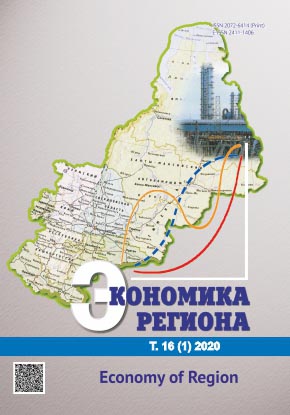ЭКОНОМЕТРИЧЕСКОЕ МОДЕЛИРОВАНИЕ ПОТЕНЦИАЛА РЕГИОНА ПО ПРИВЛЕЧЕНИЮ ПРЯМЫХ ИНОСТРАННЫХ ИНВЕСТИЦИЙ
Econometric Modelling of a Region’s Potential to Attract Foreign Direct Investments
Author(s): Igor Mikhailovich Drapkin, Evgeniya Olegovna DubininaSubject(s): Economy
Published by: Институт экономики Уральского отделения Российской академии наук
Keywords: foreign direct investment; FDI in Russia; attracting FDI in the Russian economy; FDI determinants; regional factors of FDI; Poisson quasi-maximum likelihood estimation; FDI gravity model
Summary/Abstract: In the Russian economy, foreign direct investments (FDI) are distributed very unevenly between the regions. This inequality is caused by differences in the regions’ economic characteristics, as well as by varying effectiveness of regional policies to attract FDI. The assessment of a region’s potential to attract FDI could serve as a guide for analysing the effectiveness of local authorities in terms of creating a positive environment for foreign investors. The research focuses on constructing and assessing an econometric model of FDI determinants at the regional level. The theoretical foundation for this model is a gravity approach. We used estimates obtained with the help of Poisson’s method of quasi-maximum likelihood estimation for calculating the potential of foreign direct investments. Using the data for the period from 2015 to 2017, we identified the crucial factors influencing the inflow of foreign direct investment in Russia at the regional level: availability of the workforce, level of bureaucracy, level of income, population density, and the financial results of the regional companies. Based on the calculated potentials, we identified successful and lagging Russian regions in terms of FDI inflows. We analysed and systemised the volume of FDI inflows as well as the ratio of actual/potential FDI of the Russian regions. The largest Russian regions in terms of FDI inflows have limitations in growth because they either exceed their potential level already (Moscow oblast, Krasnodar krai, Samara oblast) or are close to it (Moscow city, Leningrad oblast, Saint-Petersburg city). At the same time, more than a half of the Russian regions (41 out of analysed 82) not only have very low potential to attract FDI inflows, but also operate at a level lower than potential. A significant increase in FDI inflows across the country may be provided by a small group of regions with medium and high levels of FDI inflows but with considerable unrealized potential. This group includes such regions as Republic of Bashkortostan, Republic of Tatarstan, Sverdlovsk oblast, Udmurt republic, KhMAO–Yugra, Orenburg oblast, and Belgorod oblast. The suggested methodology for assessing a region’s FDI potential and comparing it with actual FDI inflows can be used for goal setting for relevant regional authorities and subsequent control of their efforts to attract FDI.
Journal: Экономика региона
- Issue Year: 16/2020
- Issue No: 1
- Page Range: 310-324
- Page Count: 15
- Language: Russian

